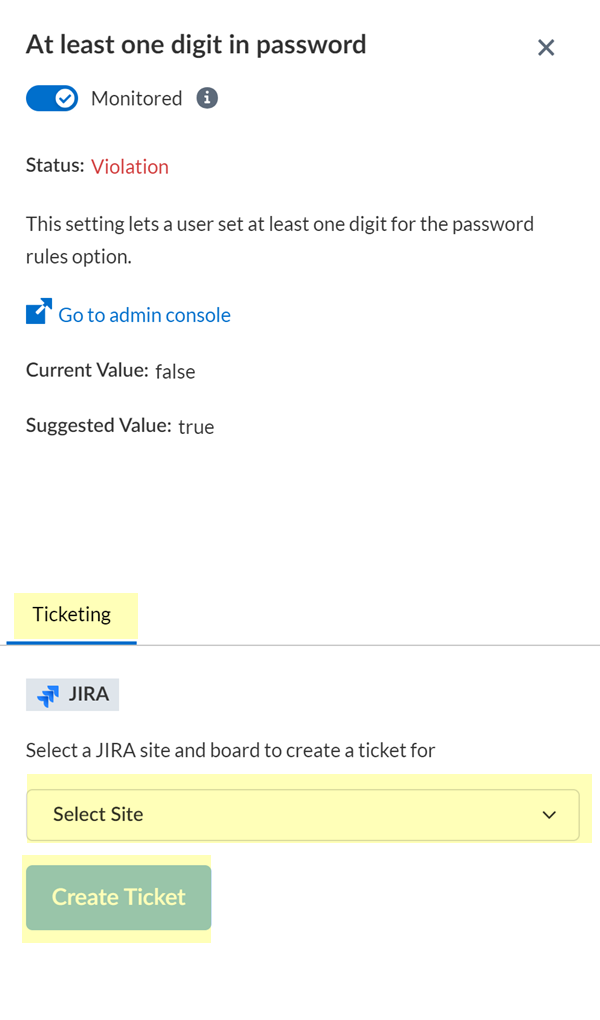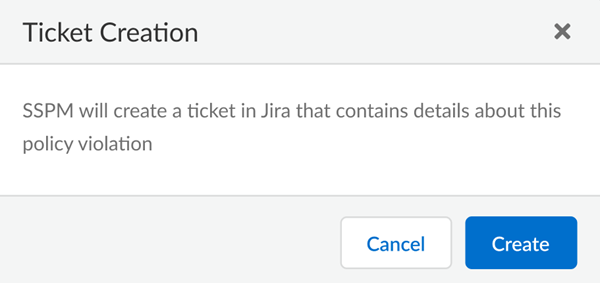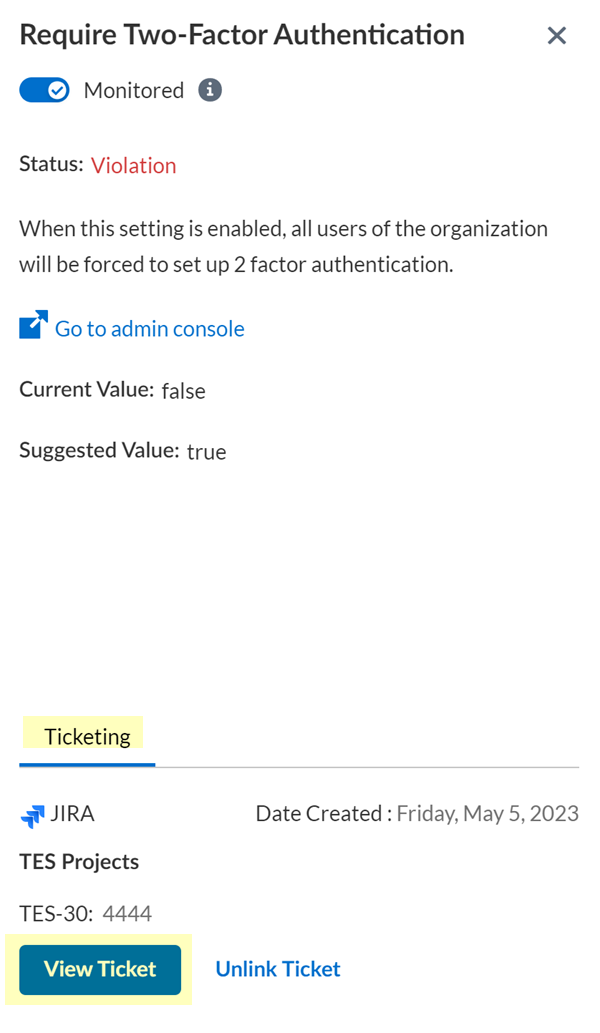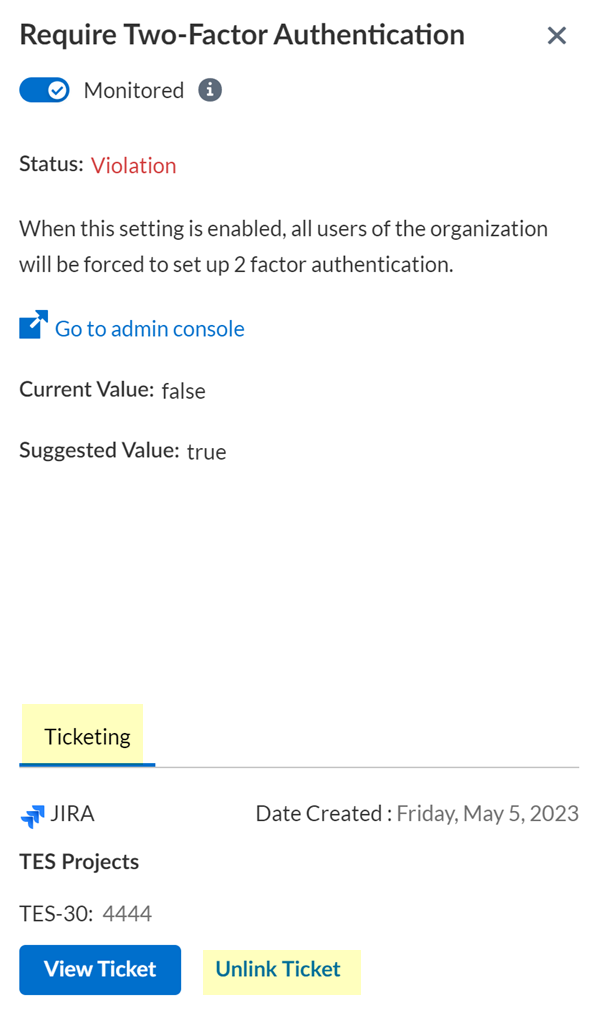SaaS Security
Create and View Tickets for Rule Violations
Table of Contents
Expand All
|
Collapse All
SaaS Security Docs
Create and View Tickets for Rule Violations
If you're using Jira to manage your team's tasks, you can create tickets in Jira
directly from SaaS Security Posture Management.
| Where Can I Use This? | What Do I Need? |
|---|---|
|
Or any of the following licenses that include the Data Security license:
|
If you're using the Jira or ServiceNow issue tracking system to manage your team's tasks,
you can create tickets in the issue tracking system directly from SaaS Security Posture Managementt.
When you're viewing a rule violation in SSPM, you can create a ticket for a team member
to investigate and resolve the misconfiguration. To create tickets in Jira, you must
first link SSPM to a Jira instance. To create tickets in ServiceNow, you must first link
SSPM to a ServiceNow instance.
When you're viewing a rule violation for an app, you can either remediate the misconfigured setting, or you can create a ticket
about the violation in an issue tracking system (Jira or ServiceNow). For example, if
the misconfigured setting must be manually resolved in the SaaS app, you might create a
ticket for an administrator of the SaaS app to resolve. When you create a ticket for a
rule violation from SSPM, the violation is linked to the ticket in the issue tracking
system. From SSPM, you can open the issue tracking system to view the linked ticket.
When you no longer need to track a ticket that was associated with a rule violation, you
can unlink the ticket from the rule violation. For example, you might want to unlink the
ticket after the rule violation is resolved and the ticket is closed. After a ticket is
unlinked, you can no longer open the issue tracking system from SSPM to view the ticket.
However, unlinking a ticket does not delete the ticket from the issue tracking system.
- Create a Ticket for a Rule Violation
- View a Ticket Associated With a Rule Violation
- Unlink a Ticket Associated With a Rule Violation
Create a Ticket for a Rule Violation
When you are viewing a rule violation for an app, you can create a ticket about the
violation in Jira.
The administrator of your issue tracking system might have configured certain
fields to be mandatory for ticket creation. When SSPM creates a ticket, it
provides values for only a few fields and might not provide values for the
required fields. For this reason, ticket creation might fail with an error
message.
For ServiceNow, SSPM provides values only for the following fields:
- Short Description
- Description
For Jira, SSPM provides values only for the following fields:
- Summary
- Project
- Issue Type
- Description
- Log in to Strata Cloud Manager.Select ConfigurationSaaS SecurityPosture Security.Navigate to a rule violation.In the rule violation, go to Ticketing.Select a Jira or ServiceNow instance.If no Jira or ServiceNow instances are linked to SSPM, you are prompted to link SSPM to a Jira instance or to link SSPM to a ServiceNow instance.Specify where you want to create the ticket, and ticket information.
- For Jira, select the Jira board on which you want to create the ticket, and the type of ticket you want to create. Specify a title, which will be assigned to your Jira ticket.
- For ServiceNow, select the ServiceNow instance. Specify a title, which will be assigned to your ServiceNow ticket.
Create Ticket.![]() A confirmation dialog box is displayed.
A confirmation dialog box is displayed.![]() Create the ticket.SSPM creates a ticket for this violation. The ticket contains details about this violation, such as the current and recommended values for the setting.
Create the ticket.SSPM creates a ticket for this violation. The ticket contains details about this violation, such as the current and recommended values for the setting.View a Ticket Associated With a Rule Violation
If you created a ticket in Jira from SSPM, you can open the issue tracking system from SSPM to view the linked ticket.- Log in to Strata Cloud Manager.Select ConfigurationSaaS SecurityPosture Security.Navigate to a rule violation.In the violation, go to Ticketing.View Ticket.
![]()
Unlink a Ticket Associated With a Rule Violation
When you no longer need to track a ticket that was associated with a rule violation, you can unlink the ticket from the violation.




